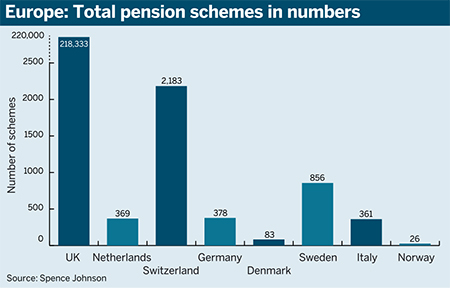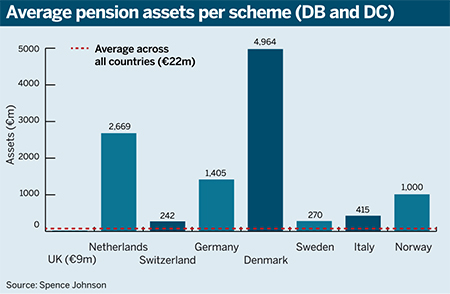Data Crunch: The appointment last month of Edi Truell as the London Mayor’s new adviser on pensions and investments is part of an initiative, we are told, to amalgamate some of the country’s numerous public sector pension funds.
Edi Truell will apparently advance the cause of pension consolidation across public sector pension funds.
You could say that this initiative is missing the point.
If you want to find candidates for amalgamation and cost sharing, you really need to look at the private sector.
Edi Truell will apparently advance the cause of pension consolidation across public sector pension funds.
You could say that this initiative is missing the point.
If you want to find candidates for amalgamation and cost sharing, you really need to look at the private sector.
UK fragmentation
There are 218,000 workplace schemes in the UK, thanks largely to the vast number of very small defined contribution schemes. But there are only 4,300 equivalent schemes in total across the Netherlands, Switzerland, Germany, Denmark, Sweden, Italy and Norway combined.

The average size of defined benefit schemes in Europe (excluding the UK) is €787m (£570m), twice the average size of those in the UK (€316m).
DC-style workplace schemes in the UK are on average tiny (€2m) compared with elsewhere in Europe (€455m).
This means the assets per scheme are much lower in the UK than elsewhere; Denmark has average assets per scheme of nearly €5bn, but the UK has assets per scheme of only €9m.
So, assets per scheme in the UK are 570 times smaller than in Denmark.

By comparison, Edi Truell’s challenge is less taxing. Local authority pension funds in the UK are much more economically robust.
There are 89 local authority pension funds in the UK, managing around £180bn. On average, each scheme therefore holds £2bn in assets.
The consequences of private sector pension scheme fragmentation in the UK are of course the ones that Edi Truell would recognise in the local authority context, but they are much more marked in the private sector.
In terms of cost, small private sector schemes in the UK face relatively much higher costs of governance than large schemes.
Consultants thrive where fragmentation deprives schemes of the economic ability to retain skilled management
We estimate that third-party adviser fees are around 4 basis points for very large schemes, but four times this for very small ones.
Unsurprisingly, small UK schemes are closing at a rate of knots – small DB schemes have been closing for years.
Now, small DC schemes are flooding into mastertrusts in the UK because these new collective structures typically offer cost reductions of 50 per cent on what members of small schemes would have to pay if their scheme remained a standalone one.
It seems strange perhaps that it takes an outsider like the London mayor and Edi Truell to shine a light on this.
Why have pension insiders in the UK private sector, such as pensions consultants, not been trumpeting this issue for many years?
Well, the truth is that consulting firms have a tight grip on around £700m worth of investment and governance-related fee income from private sector pension schemes precisely because of this fragmentation.
Consultants thrive where fragmentation deprives schemes of the economic ability to retain skilled management.
This skill frequently resides in the large schemes (such as Edi Truell and his team in the London Pensions Fund Authority) that are common in continental Europe, but relatively rare in the UK.
Magnus Spence is managing director of Spence Johnson














